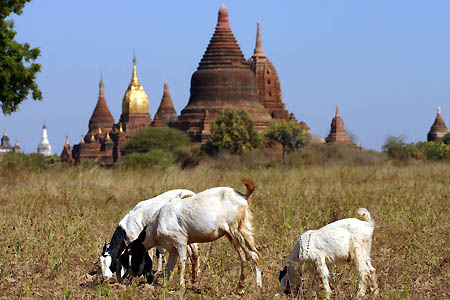
|
|
|
||||||||||
|
|
|||||||||||
|
|
An Introduction to Myanmar Len Gao
|
|
|||||||||
|
|
|
||||||||||
An Introduction to Myanmar
Len Gao
The mighty Thatbyinnyu Pahto (left, 61 metres high, mid-12th century) and Ananda Pahto (middle, 51 metres high, early 12th century) dominate Bagan's skyline and dwarf the modern archaeological museum (centre) in the background.
Dated from mid-9th century to modern day, thousands of temples, pagodas and stupas pack in a small area by the Ayeyarwady River in central Myanmar, making Bagan one of Asia's, perhaps the world's, most hidden archaeological treasures. Even today, photographers and tourists are still allowed to climb most of the monuments to observe the panorama during the sunrise and sunset..
No one is certain about the exact number of monuments in Bagan archaeological zone, since new ones are constantly being constructed, and old ruined. Depending different historical periods and counting methodology, the number ranges from 2,100 to more than 4,400.
A balloon kisses the Thabyinnyu Pahto during the morning hour. Foreign entrepreneurs have siezed yet another economic opportunity. However, with the local economy, the $200+/person price tag seems to be astronomical to the locals, or even budget foreign travellers.
Chariot of Fire. Unlike other archaeological sites, Bagan still mingles with daily life of people living along the Ayeyarwady. Not far from the Ananda Pahto, a farmer burns shrubs to fertilise his cultivated land.

Local women harvest before the backdrop of the Htinominlo Pahto (above) in the morning, while sheep graze amid a forest of pagoda at high noon (below).
